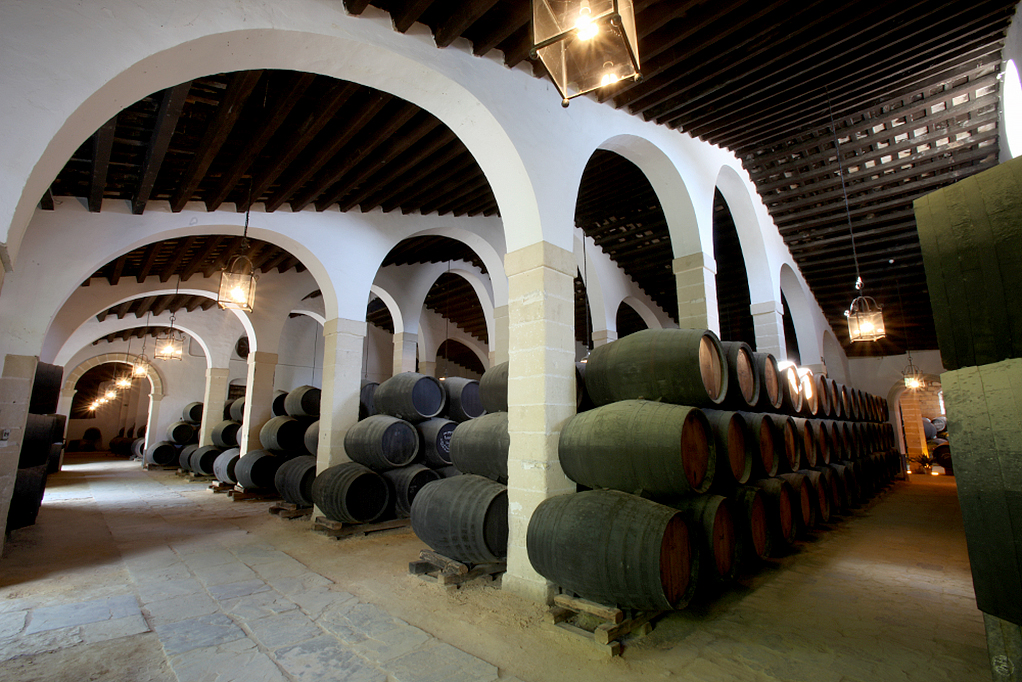Pale gold color; yeast, toasted almonds on the nose; white fruit flavors, lemon, salinity on the palate.

Dry; excellent acidity; fruity and rich; refreshing; somewhat oily mouthfeel (a plus); 15% ABV. This is a benchmark mass-market fino. Sherry and its saltiness and astringency makes it a love-it-or-leave-it wine. If you try this, don’t give up on the first sip. Fino sherry grows on you. Serve this very cold.
Made with palomino grapes; only free run and first gentle press used in Tio Pepe. The wine ferments to 11-12% ABV, then is fortified to 15% ABV and placed in solera—a type of vintage blending system to maintain consistency where wine barrels are stacked and the wine is blended down to the next barrel each year; the name comes from the suelo [floor] where the final barrel in the process is located.
Barrels are never fully filled so a layer of yeast called “flor” forms on the surface of the wine, giving it a unique aroma and character. This system is the standard system in Jerez, where this wine was made. The wine remains in barrel and in contact with the flor for a minimum of four years. Flor provides a key element in sherry’s taste. In vintage sherry, the flor presents differently in each vintage. This is a blend of vintages, so the year-to-year differences are muted.

The story of the Tío Pepe name, according to the website: “In 1835, when the sound of horses hooves could still be heard making their way through the streets of Jerez, José Ángel y Vargas and Francisco Gutiérrez de Agüera walked along with Tío Pepe’s 23-year-old nephew, Manuel María González Ángel, who was starting out in the wine business. Manuel Maria found in his uncle his greatest support.
“During those years, José Ángel, or Tío Pepe (Uncle Joe), started buying little amounts of the finest casks of sherry and experimenting with them in order to obtain the perfect wine. It was quite usual to see José Ángel tasting pale fino wines with friends near the cathedral, in the Tío Pepe Rebollo cellar (original solera of the Tío Pepe wine). This is why this wine started to be known popularly as ‘Tío Pepe’, in honour of this endearing, extroverted man, with such an exquisite taste for wine.
“Some years later, the founder Manuel María González Ángel baptized this solera as the ‘Tio Pepe Solera’, as can still be seen in one of the andanas’s cask inscriptions. This is how the legend of the most famous fino in Spain and the world was born.”
Gonzalez Byass Tio Pepe Fino Muy Seco Sherry, Jerez Xérès NV has nice complexity and classic NV fino sherry notes. The acidity, salinity, and astringency are why some people adore sherry and others do not. Give this a try, and drink more than one glass—you drink sherry in small glasses—and discover how profound and different sherry can be. Sherry often is consumed as an aperitif with olives and Iberian ham and cheese. Because of its acidity and low levels of acetic acid, it pairs with seafood, fish, and salads and dishes with high levels of vinegar (green pimento-stuffed olives are particularly nice). Sherry also is an ingredient in cocktails; there is a Tio Pepe Challenge that attracts more than 400 professional mixologists each year. $20
Promo for the Tio Pepe Challenge
Interesting documentary on sherry and flamenco; “Sherry Fusion”







